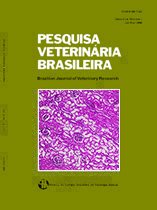 |
|
|
|
Year 2015 - Volume 35, Number 3
|

|
Ultrasonographic evaluation of reproductive tract in viviparous snakes Boidae family, 35(3):311-318
|
ABSTRACT.- Garcia V.C., Vac M.H., Badiglian L. & Almeida-Santos S.M. 2015. [Ultrasonographic evaluation of reproductive tract in viviparous snakes Boidae family.] Avaliação ultrassonográfica do aparelho reprodutor em serpentes vivíparas da família Boidae. Pesquisa Veterinária Brasileira 35(3):311-318. Programa de Pós-Graduação em Anatomia dos Animais Domésticos e Silvestres, Departamento de Cirurgia, Faculdade de Medicina Veterinária e Zootecnia, Universidade de São Paulo, Avenida Prof. Dr. Orlando Marques de Paiva 87, Cidade Universitária, São Paulo, SP 05508-270, Brasil. E-mail: viviane.garcia@butantan.gov.br
The reproduction is part of the animal life cycle allowing the perpetuation and conservation of the species. In snakes, there is a shortage of technical information about the reproductive cycle. The objective of this study was to evaluate the reproductive tract by ultrasonography in captive viviparous snakes of the Boidae family, allowing diagnose of the different reproductive stages. Eleven adult snakes of four species of the Boidae family were sonographically evaluated, Eunectes murinus, Boa constrictor constrictor, Corallus hortulanus and Epicrates cenchria belonging to the Biological Museum’s collection of the Instituto Butantan, Sao Paulo Brazil. For the sonographic evaluation, snakes were contained physically with herpetologic hook and then manually for about 15 minutes. The evaluation was done by applying acoustic gel on the skin and positioning the transducer on the right and left side-ventral line, in the medial region of the body in the skull tail sense. Ultrasonography allowed the evaluation of the whole reproductive cycle in snakes. In sonographic evaluations of females were defined the stages of ovarian and ovidutal development. The ovarian follicles during the pre-vitellogenic phase were visualized as homogeneous and anecogenic, in a “bunch of grapes” distribution. In the vitellogenic stage follicles were larger and more echogenic, following each other as a “string of pearls”. When there was no copula, the follicles were reabsorbed in the ovary returning to pre-vitellogenic phase. In the post ovulatory phase were seen three well-defined stages of fetal development within the oviduct: 1) just after ovulation (and fertilization), only the vitellus was visualized; 2) occupied 60% of the vitellus fetus and 40% egg and 3) the fetus was formed and no vitellus. In males, the testicles were seen as a homogeneous and hypoechoic image during the reproductive stage. When the males were not on a reproductive state, it was impossible to visualize the testicle due to its size. The sonographic evaluation of the reproductive tract of snakes proved to be a safe diagnostic technique, noninvasive and allows the monitoring of reproductive phases. |
| |
|
|
| |
|
 |